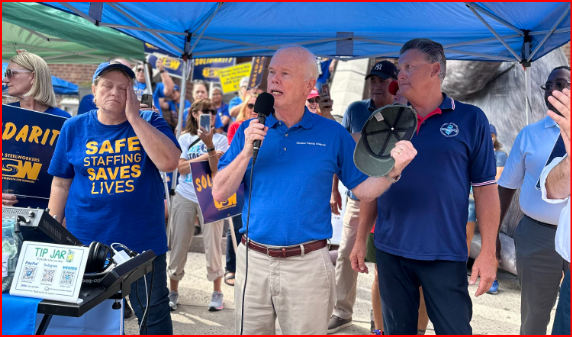Week Two: Support for Striking RWJUH Nurses Grows

As the nurses’ strike at New Brunswick’s Robert Wood Johnson University entered its second week, sources say the major sticking point is what sort of enforcement mechanism can be relied on to ensure the hospital maintains whatever levels of staffing that it commits to.
Over the weekend and through a high energy rally on Monday night, United Steel Workers Nurses Local 4-200 got a major show of support from elected officials as well as from New Jersey AFL-CIO New Jersey State AFL-CIO President Charles Wowkanech and Rebecca Damon, the president of New York SAG-AFTRA, which is itself been on strike for a month.
“Hospitals have been downsizing their staffs over the years to try and save money at the same time that some of the hospitals are full—so safe staffing is something that nurses—not just in New Jersey—but all over the country are looking at,” Wowkanech told InsiderNJ. “The issue isn’t just about the nurses, it’s about you and I and our families. Someone gets sick and goes to the hospital and they got one nurse for eight or nine patients, particularly some of these wards with infants or you have intensive care units where people need pretty much constant attention. That’s really what the fight is all about.”
“The pandemic clearly illustrated the dedication and resilience of these workers who risked their health to battle COVID on the front lines of patient care” Wowkanech said in a statement. “Now, with the pandemic behind us, we see even more clearly how understaffed hospitals are and how this is having a direct adverse impact on patient care and hospital staff.”
“Unfortunately, many hospitals are putting profit over people – and the quest for increasing profits in the healthcare industry is the number one reason why hospitals refuse to adequately staff their facilities” said New Jersey State AFL-CIO Secretary/Treasurer Laurel Brennan.
Last week, hospital management issued a statement that their latest offer had been rejected that management said, “would have established clearly defined staffing guidelines, further bolstered nurses’ highest-in-the-state salaries and ensured zero increase in employee health contributions for a fourth consecutive year.”
Judy Danella, RN and president of United Steelworkers Nurses Local 4-200, told InsiderNJ the offer was a non-starter because if nurses had to call out sick “there was no requirement for the hospital to fill in the staffing gap.”
Danella confirmed that the union is scheduled to meet with the federal mediator on Wednesday.
Political support for the striking nurses continued to grow.
“Today, I stood with our dedicated & talented nurses who sacrifice so much every day,” tweeted Rep. Josh Gottheimer (D-5th Dist.) on Monday. “Our families here in New Jersey can’t be healthy without their hard work. That’s why I’ll always get their backs—because they always have ours.”
Senators Joseph Vitale (D-19), Patrick Diegnan (D-18) and Andrew Zwicker (D-16) rallied Monday as well as New Brunswick Councilman and IBEW Local 456 Business Agent Kevin Egan.
“I have to say I never knew the nurses were unionized with the Steelworkers which doesn’t surprise me because you are made of steel—you hold up this building more than the steel does,” Assemblyman Joe Danielsen (D-17th Dist.), told hundreds of striking nurses at Saturday’s rally.
The New Brunswick facility is one of a dozen acute care hospitals in the RWJBarnabus system that has a partnership with Rutgers University which makes it the state’s largest academic healthcare system. It has 38,000 employees and $6.6 billion in revenue.
The system’s recently retired CEO and Present Barry Ostrowsky earned $16 million in the second year of the pandemic, making him the highest paid hospital executive in the New York area, according to Crain’s New York.
Back in the spring, HPAE, the state’s largest nurses’ union, with the strong support of the NJ AFL-CIO, held a major rally launching a statewide campaign to get Trenton to enact nurse-to-patient staffing ratios as was done in California in 2004. In the years since, peer reviewed studies documented that California saw greatly improved patient outcomes, workplace safety, as well as nurse retention.
The renewed push for the staffing requirements comes as a national survey predicted New Jersey would be shy 11,400 nurses by 2030, ranking it in the top ten states with a severe shortfall. Also, in that crisis mix Connecticut (27,926), New York (18,784), and Pennsylvania (16,430).










Are you accepting nurses and CRNP’s with Pa licenses to assist with staffing?
Who are you asking?
This article says 8-9 patients? When and where? I’m a nurse have not worked in quite a few years and will be back soon, but 6 patients pushes the limit. If I walked into work and I had 7 patient workload I would walk out hands down. Documentation alone takes 1/3 of the day on 6 patients and that’s scary/questionable. Beyond that no. 5 should be the limit hands down.